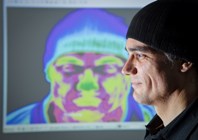Beyond the face

Professor Reyer Zwiggelaar
11 March 2010
It’s written all over their face - Aber researchers exhibit the lie detection technology of the future
In a groundbreaking new partnership, researchers from Aberystwyth University have been collaborating with designers from the Royal College of Art to visualise the potential impact of scientific developments and examine how they might affect how we live in future Britain.
The results can be seen at the IMPACT! exhibition which offers a powerful insight into how today’s research might transform our experience of the world. IMPACT! runs from Tuesday 16 March until Sunday 21 March at the Royal College of Art, London.
Chosen by designers at the Royal College of Art, the capabilities of Aberystwyth University’s real-time dynamic passive profiling technique, which allows users to observe individual’s feelings and emotions, beyond what is expressed visually, will be demonstrated at the exhibition.
Professor Reyer Zwiggelaar, lead scientist at Aberystwyth University’s Computer Science Department, explains: “This new technology is based on the modelling of facial expressions, eye movement and pupil changes in both the visual and thermal domains and links these to emotions and physiological processes such as blood flow, eye movement patterns and pupil dilation.”
James Auger, designer at the Royal College of Art, chose to work with Aberystwyth University to show how the profiling technique, which is funded by the Engineering and Physical Sciences Research Council (EPSRC), may be used within domestic situations within five to ten years.
Professor Zwiggelaar said: “Individuals, to a certain extent, are able to manage their facial expressions and mask their true emotions. Our technology combines both thermal and visual information to enable us to gain an insight into individuals’ true feelings and whether or not they are telling the truth. We anticipate that the technique will provide useful information about a person’s emotional wellbeing.”
Aberystwyth University’s primary aim in developing this technology is to support UK Border Agency in detecting when individuals are carrying contraband.
The project includes a further dimension of collaboration between the arts and sciences: Keats-Shelley Prize winning poet, Dr Richard Marggraf Turley, from the Department of English and Creative Writing has collaborated with James Auger in composing short narratives that explore how emotion detection might play an interactive role in the lives of a family who have installed the technology in their home.
Professor Robert Winston, who will launch the exhibition, said: “Through the eyes of design, this project offers a fresh and creative insight into how the ideas that scientists and engineers are working on today might transform our quality of life and tackle the challenges we face in the 21st century in areas like engineering healthcare, transport, digital communications and the creative industries. It also offers a reminder that many of the conveniences and comforts of daily life have their origin in UK scientific endeavour, and a fascinating exploration into possible relationships between science and society in the future.”
Professor Anthony Dunne, Head of Design Interactions at the Royal College of Art, said: “Normally as designers we’re trained to look at applications from science to see how we might solve problems or come up with a new market opportunity. What we are trying to do with this project is to move sideways and look at the influence that science might have on people and how science might lead us to new social, cultural or economic pathways. Though the design projects in this exhibition offer an alternative view of how science could influence our future, there are no solutions here, or even answers; just questions, ideas and possibilities. They probe our beliefs and values; they challenge our assumptions; and they help us see that the way things are now is just one possibility.”
The IMPACT! exhibition is the first collaboration of its kind between the UK’s main funding agency for science and engineering - Engineering and Physical Sciences Research Council (EPSRC), the National Endowment for Science, Technology and the Arts (NESTA) and the Royal College of Art.
Sixteen original design installations will explore how we might interact with new technologies drawn from the latest research, and offer scenarios of how science might influence our future.



